The Buck Compadre Is Equal Parts Camping, Bushcraft, Survival, and Hunting Knife.
The Buck Compadre very much the kind of knife that we all love around here. Almost every element of it is exactly the kind of thing we hope to see and feel in a camping knife:
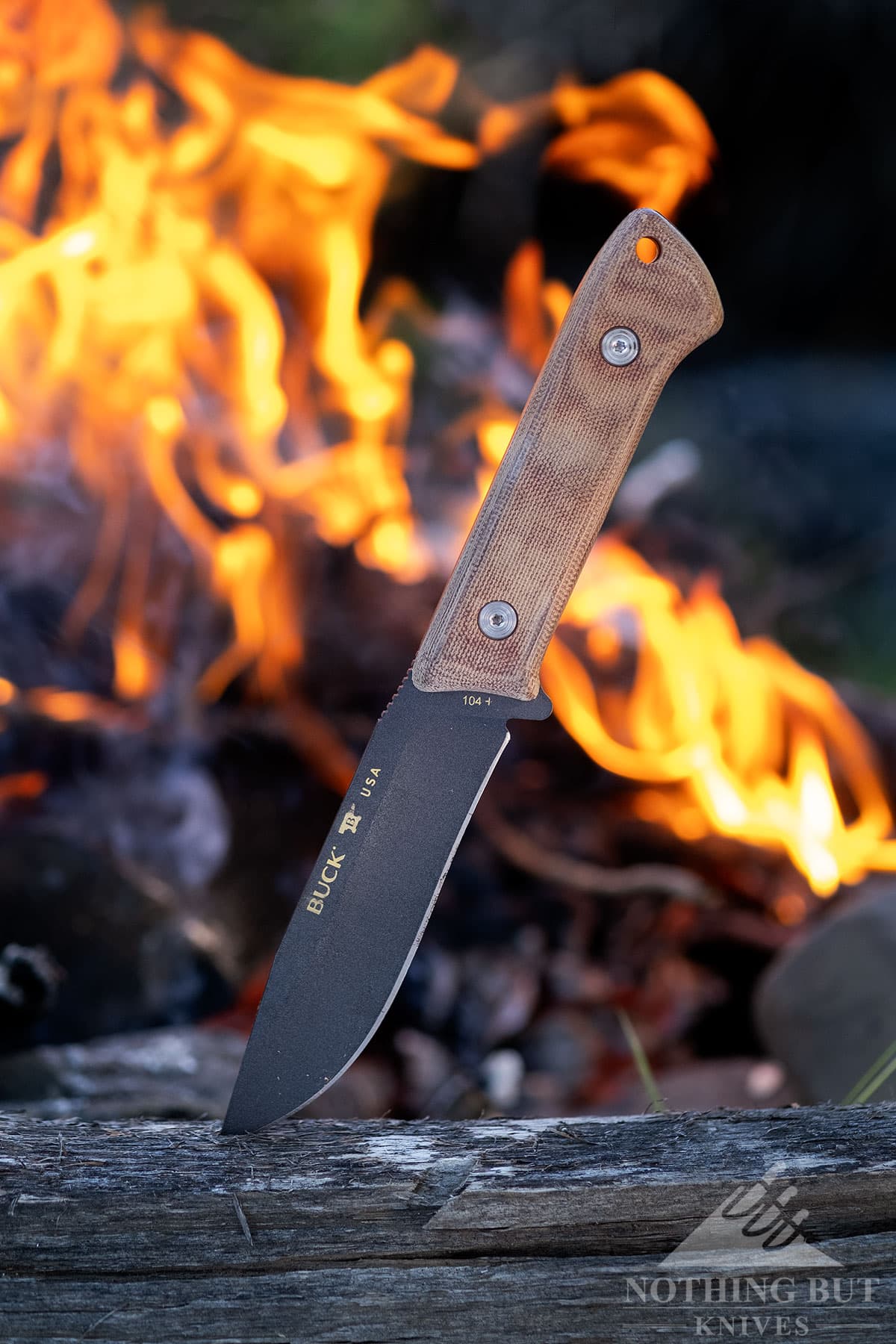
It’s the kind of knife that, at first, makes every outdoor task easier, then highlights how bad you actually are at all those tasks because it cuts so smoothly. I even like the sheath, despite its being restricted to vertical carry. The only real issue is how thinly they ground the tip, and there might be some problems with the coating scraping off over time, which in turn leans into the steel being prone to rusting, but all these problems are manageable.
Specifications
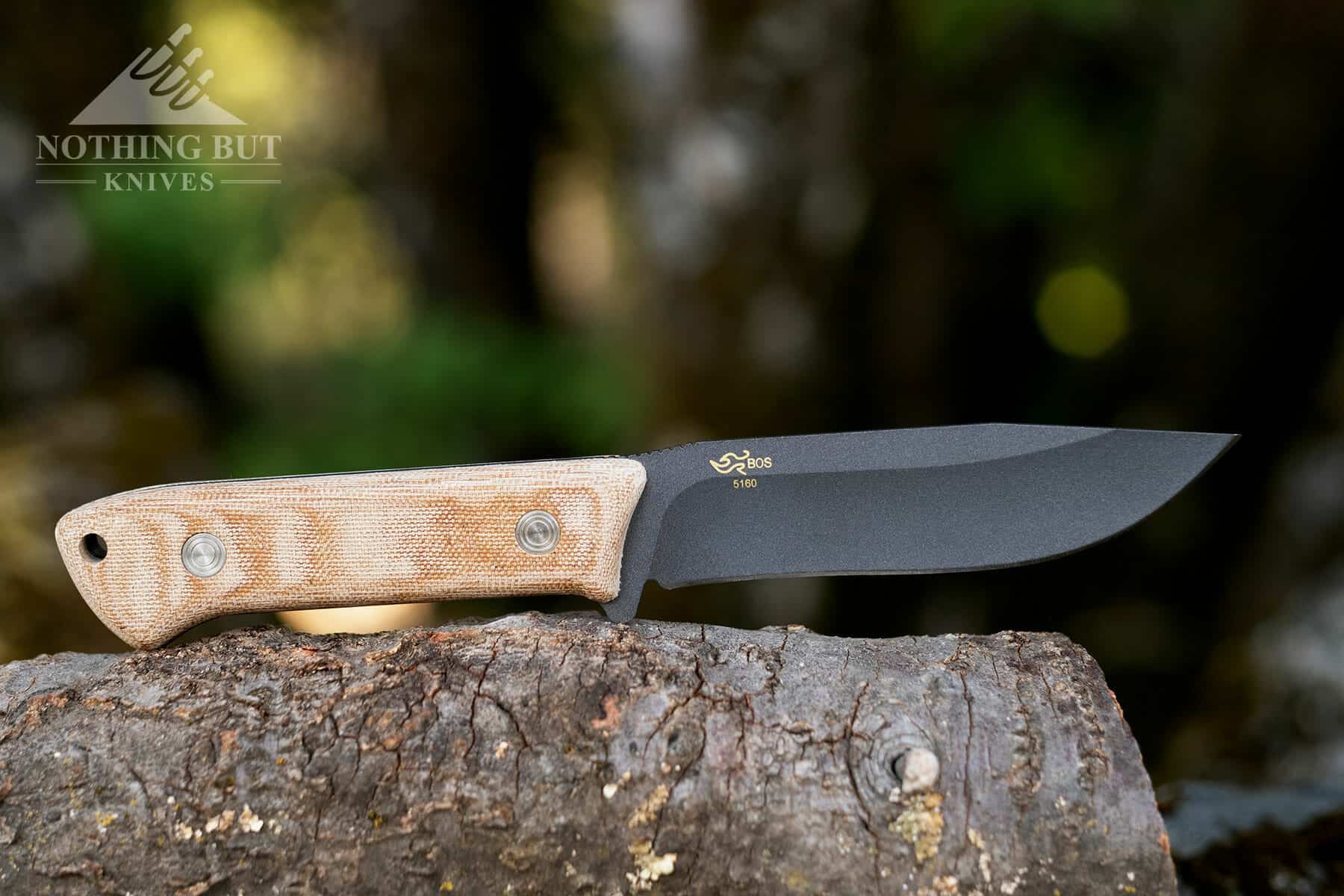
| Overall Length: | 9.5″ |
| Blade Length: | 4.5″ |
| Handle Length: | 4.0″ |
| Blade Steel: | 5160 w/ Cerakote coating |
| Blade Grind: | Hollow |
| Blade Style: | Drop point |
| Handle Material: | Micarta |
| Knife Weight: | 7.285 oz |
| Weight w/ Sheath: | 9.405 oz |
| Sheath: | Leather |
| Made in: | USA |
| Price Range: | $100 – 108 |
Pros
| Sharp edge with a good grind |
| Comfortable in the hand and on the belt |
| Sparks well off a ferro rod |
| Buck lifetime warranty |
Cons
| Thin tip has been a breaking issue for some |
| Edge is prone to rust |
| Coating comes off on ferro rod |
The Compadre Series and Color Choice
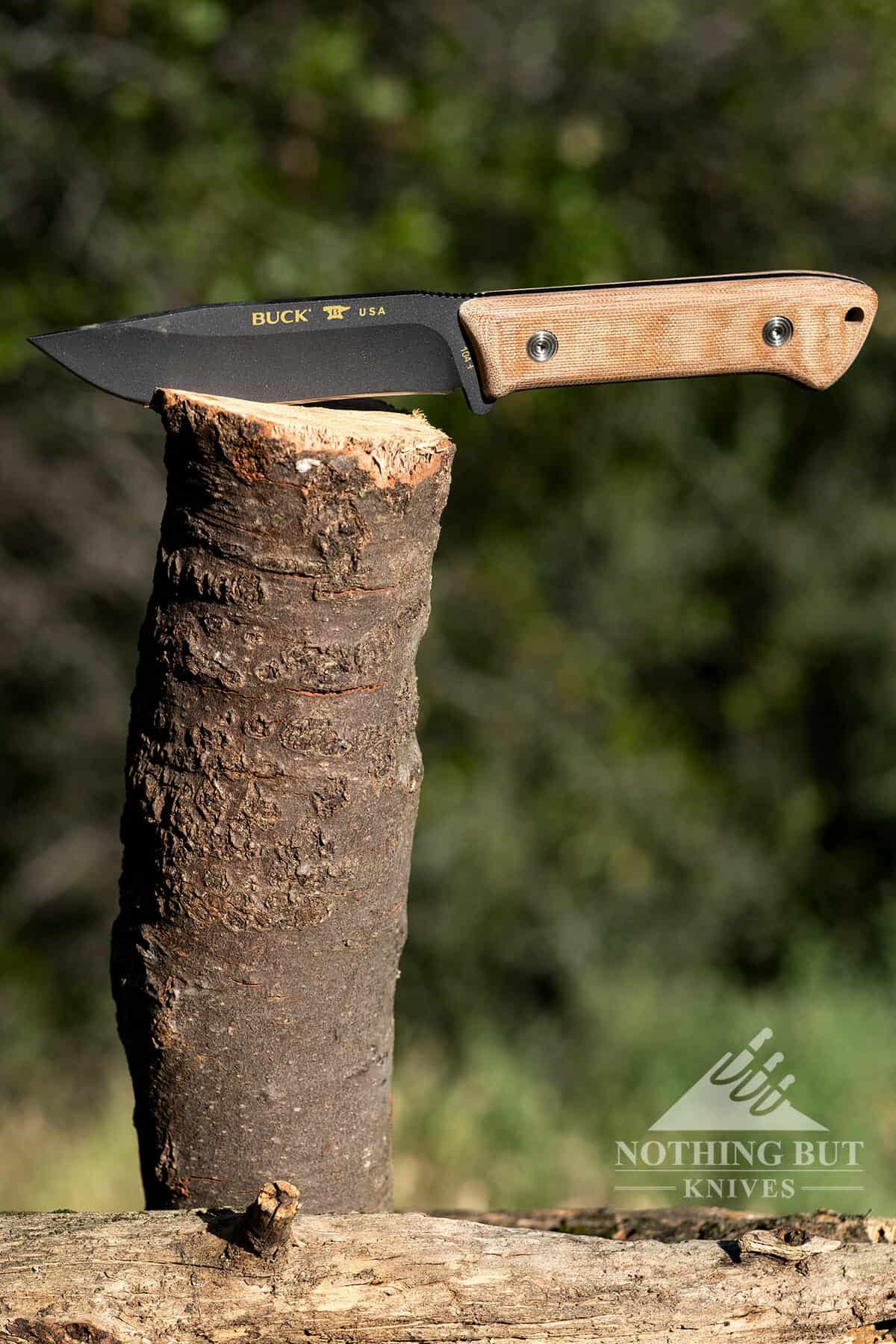
The Compadre Camp knife has actually been around for a few years now, just not in this exact form. When it first hit stores it had Buck’s synthetic Dymondwood scales and, unfortunately, a bright red powder coating. That blaring red color was supposed to be the Compadre series theme. Buck released two other tools along with it: the 108 Compadre Froe which is basically a machete, and the 106 Compadre Axe. All painted red and proud.
This was a big turn off for a lot of people. I think the color was supposed to make it easier to find if you drop it in the woods or a creek or something. It’s also possible they were just excited about using their new in-house Cerakote lab and went buck wild on playing with color.
But the Compadre Camp is a big knife. Making the blade all red makes it look a lot more terrifying than it actually is. It was still a good knife, though. Good enough that people actually started stripping off the coating and putting on their own.
Now that Buck has updated the Compadre with a black powder coating and Micarta scales, they’ve got something pretty spectacular on the shelves.
It is also, however, a bit more expensive than it used to be. I think when it first came out, the Compadre Camp was in the $70 range. If you prefer the red color, the Dymondwood scales and the lower price tag, I’m pretty sure you can still find the older version in a few places, but after handling the updated knife I can’t in good conscience recommend getting this knife without Micarta.
Ergonomics
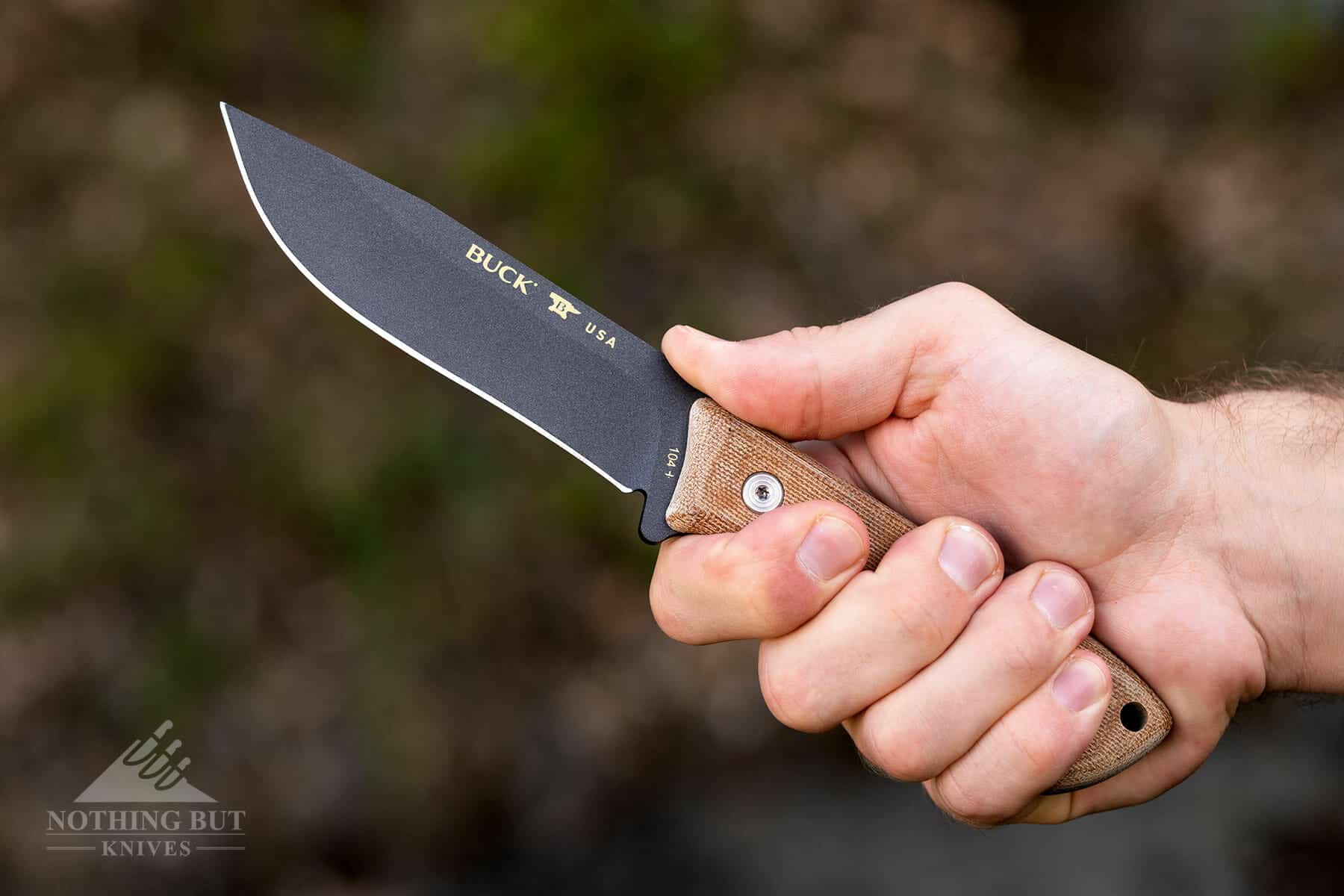
This is definitely one of the most comfortable fixed-blade knives I’ve handled in a while. Every time I did a different test on this knife I found myself thinking how some small thing in the handle and the overall shape was a clever way to make that task easier. It falls a little with the sheath, but even that comes out looking good compared to a lot of other sheath systems Buck puts out.
The Handle
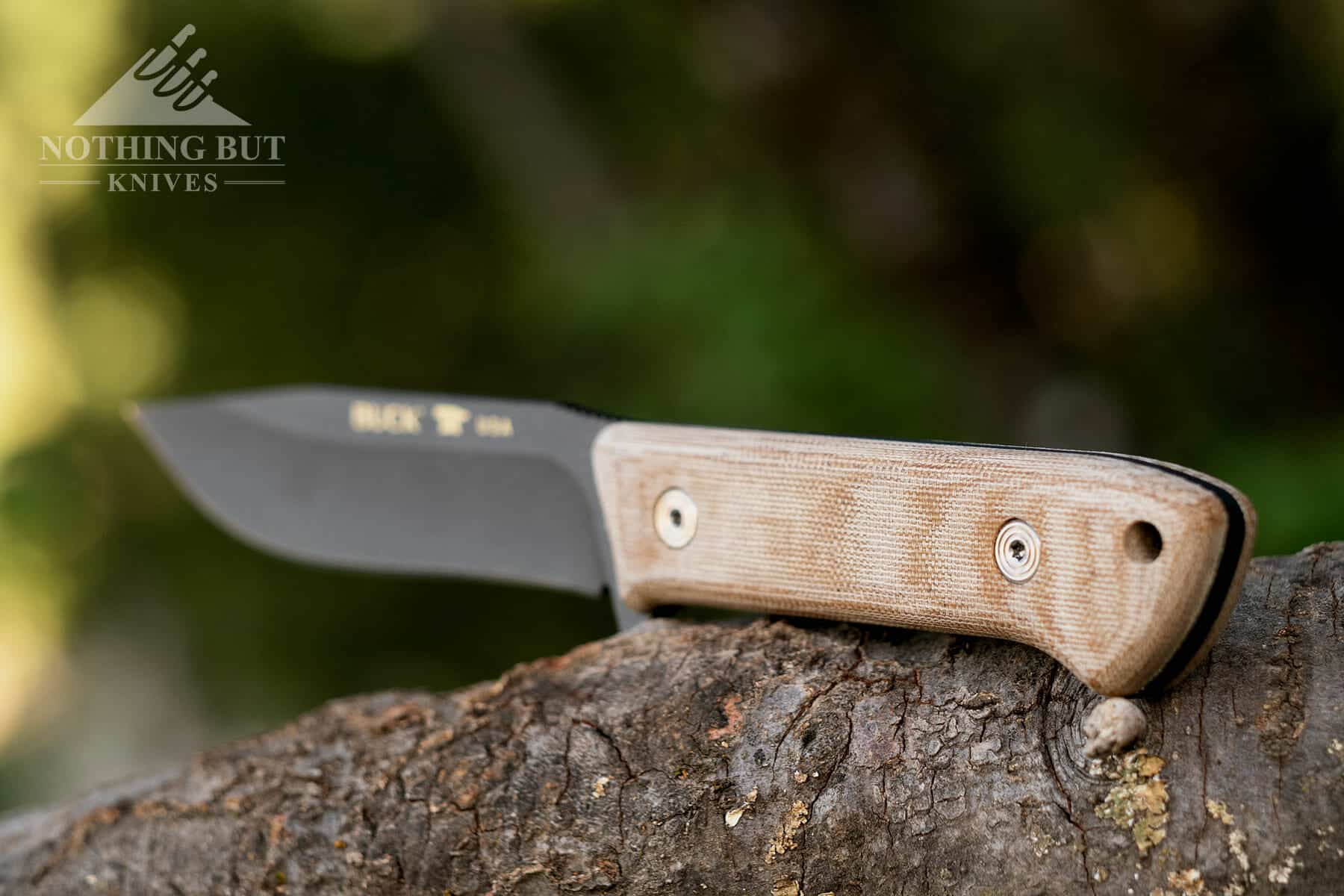
When I think of Micarta scales, these are what I think of as the ideal. I want all Micarta scales to be like the Compadre’s.
The scales have just about the right amount of softness and they’re ground with nice rounded edges that feel pretty fantastic. That little bump they’ve got on the butt makes this thing a dream for chopping, and the cross guard manages to give your finger good support and protection. Even the thumb ramp is angled well enough that it almost feels like you’re choking up the blade. So you can maintain a lot of control over the blade near even without a finger choil.
I could nitpick and complain that the tang isn’t flush with the scales, and if you’re a perfectionist that might bother you, but I haven’t noticed that creating any hot spots as I use the knife.
The Micarta does stain pretty easy. My grimy hands left some oil stains almost immediately. Also my blood, after accidentally nicking myself a good 60 miles from any band-aid, definitely left some stains on this thing. But it still come out looking okay. This is a camp knife. It was really made to be stained with oil and dirt and blood.
The Sheath
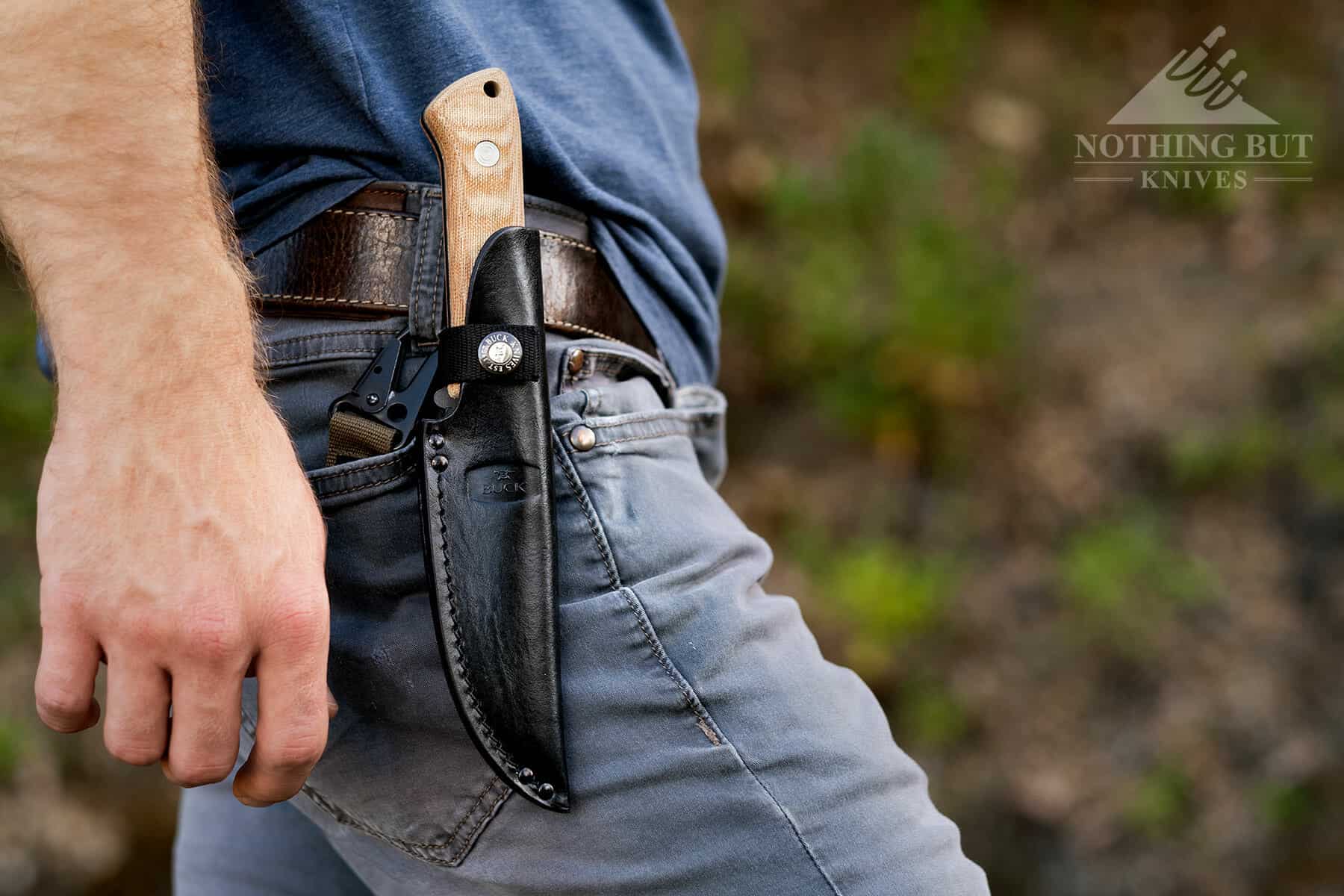
The sheath is okay. It could be better, but based on other Buck’s I’ve carried, I know it could also be a lot worse.
This one, at least, doesn’t ride too low or too high. It doesn’t bounce on my leg while I’m hiking, and it feels overall pretty tight to the body. The nylon strap that buttons across the handle helps it ride easy, and it holds pretty well without being too hard to unbutton with one finger. So even drawing it goes pretty smoothly.
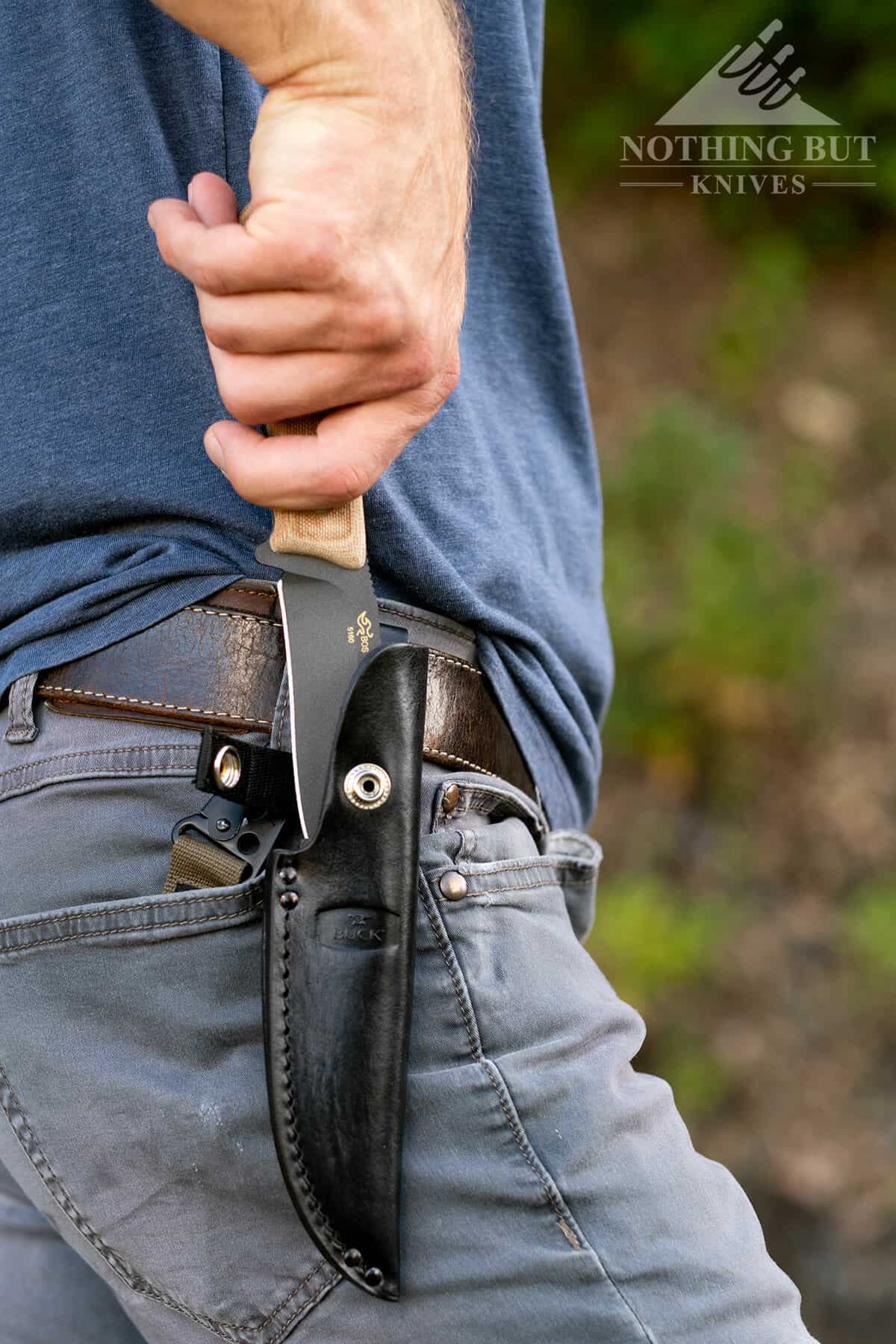
It feels nice enough that I’m not really even crying for a horizontal option (although I would take that in a heartbeat if they made it).
It’s one of the few vertical carries we’ve tested that I didn’t want to take off when we started testing other stuff, and even kind of forgot about when we started climbing around on rocks and cliff sides.
It didn’t even really get snagged too much when we were hiking through heavy brush because it hugs pretty tight to the body.
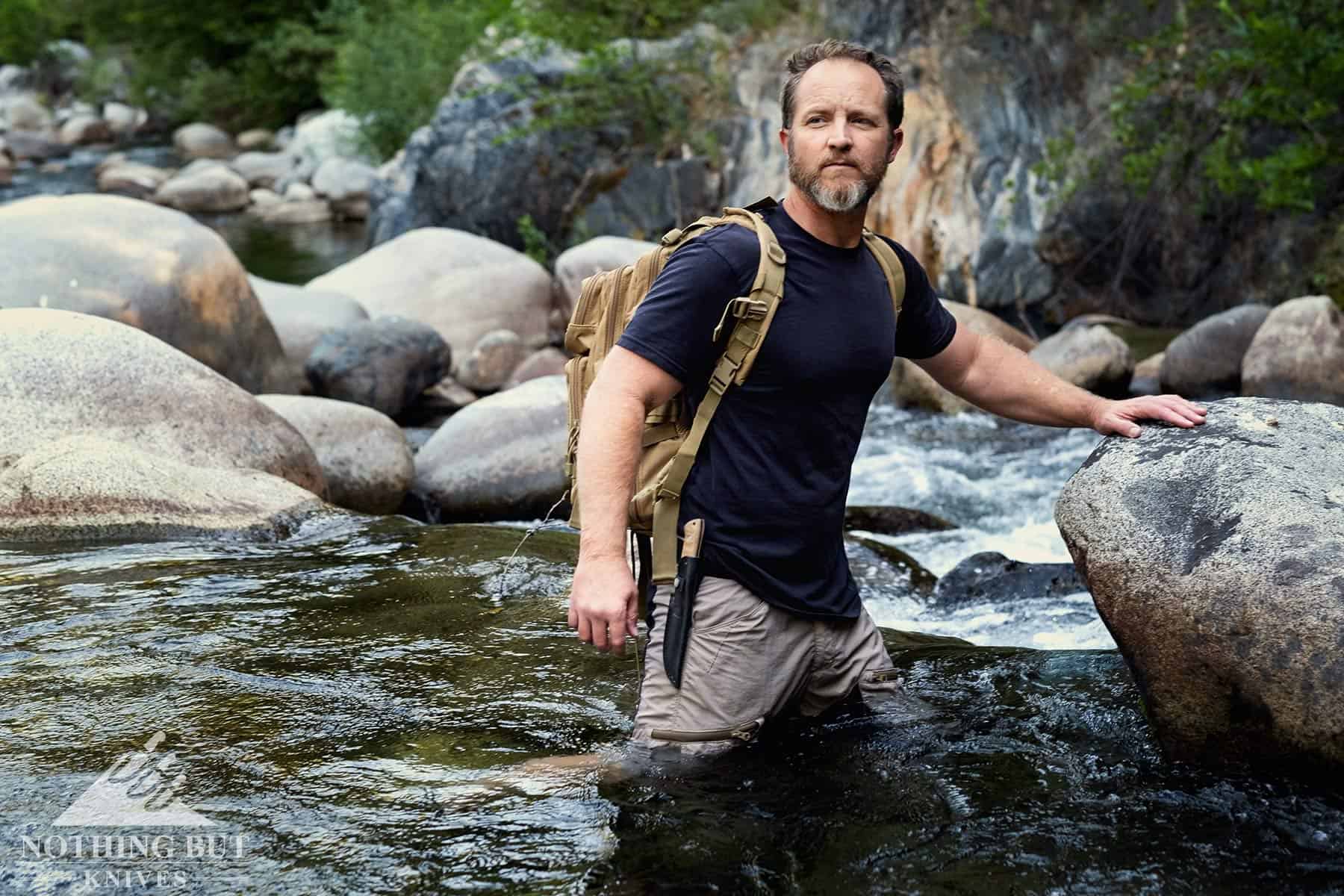
I would like to see this in a Kydex sheath with some kind of MOLLE compatible strap because it’s genuinely the kind of knife I’d love to take anywhere. It would really be ideal to have a system that let my cross draw it off my hip at a canted angle, but maybe that’s asking too much.
As this stands, it was easy enough to move around. It sits low enough that it almost never pokes into the waist or lower stomach the way some higher riding sheaths do, and the leather is pretty nice even after hiking through the elements with it.
The Blade
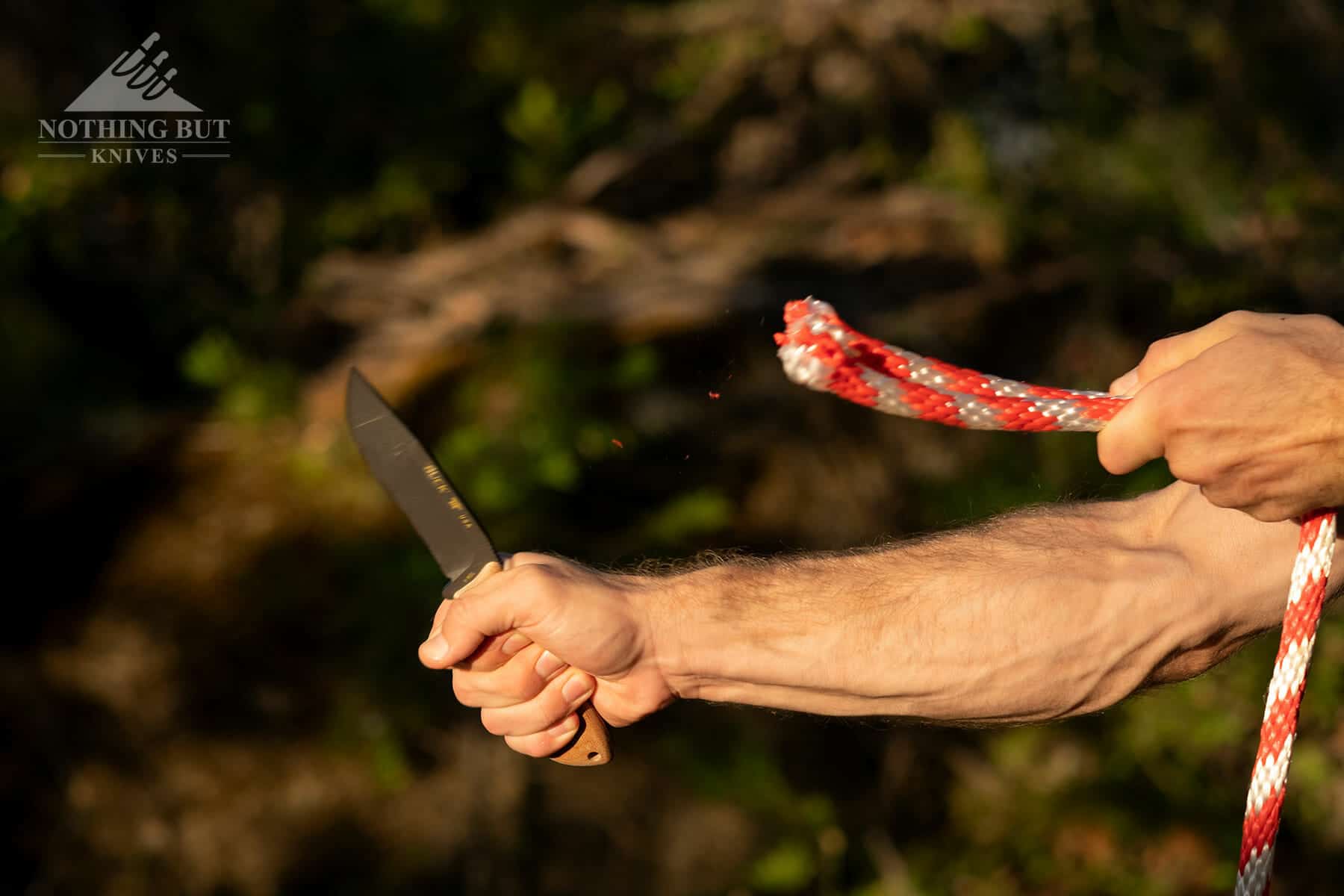
This thing is a lot sharper than I thought it looked. You might catch some blood spots in these pictures that serve as evidence of my surprise. It continued to surprise me in everything I used it on. It cuts and carves wood and rope like butter (like really cold butter, but still with the ease of an inherently soft material).
I think a few self proclaimed survivalists might turn their nose up at the hollow grind, and I’m almost there with them. It’s not the toughest grind in the world, and doesn’t seem like a great pairing with a soft steel or a semi-bushcraft blade. I honestly don’t know if the Compadre Camp would be better with a flat grind; I’m pretty sure it would be better with a scandi grind.
But Buck likes their hollow grind, and it’s doing fine on this knife so far. The only thing I think it gave me trouble with was batoning. Where a flat grind probably would have split a log halfway down, I had to take the Compadre almost down to the bottom before I got a proper split.
Steel and Coating
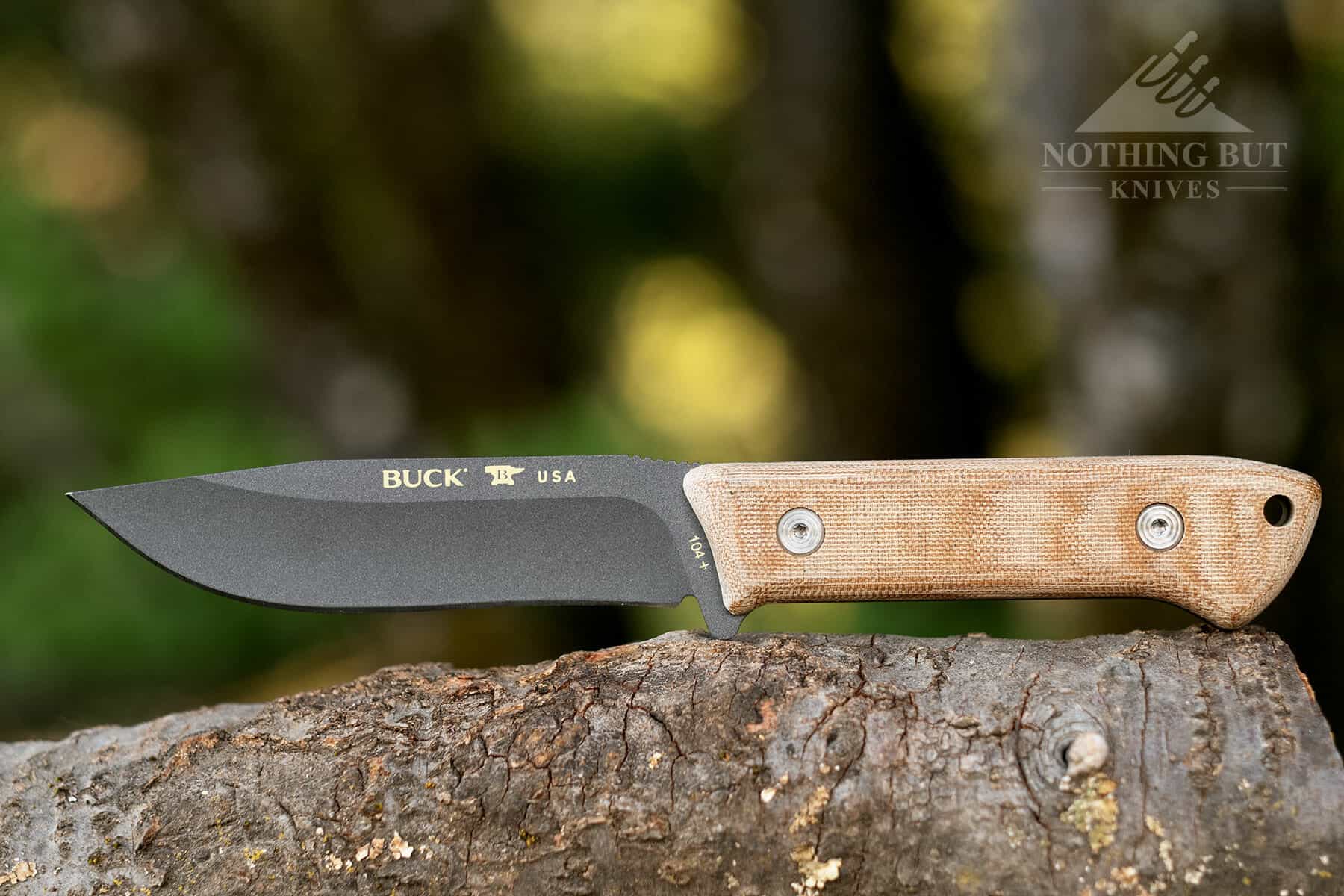
They chose to run 5160 steel because (I think) it’s just about the toughest steel you can put on a knife, and it’s a lot easier to sharpen in the field. It does have some problems with rust, but so long as there’s a decent coating corrosion resistance isn’t too big of a problem.
Out of the box, the only part you have to worry about is the edge of the knife since there’s no coating there. It should never be too much of an issue so long as you keep the knife clean and dry after heavy use.
It could become a bigger issue for people who live in muggier climates like Florida or plan on taking the Compadre Camp somewhere near the equator. But, frankly, if you’re fine with packing the 1095 steel on an ESEE knife into the jungle, you shouldn’t be much more worried about Buck’s 5160.
The Cerakote coating does well enough to protect the knife for the most part. I really haven’t put it to an extreme test beyond a camping trip up the mountains, but I did wait a few days to do any kind of proper cleaning and oiling and never saw any kind of rust spot or signs of corrosion.
Ferro Rod
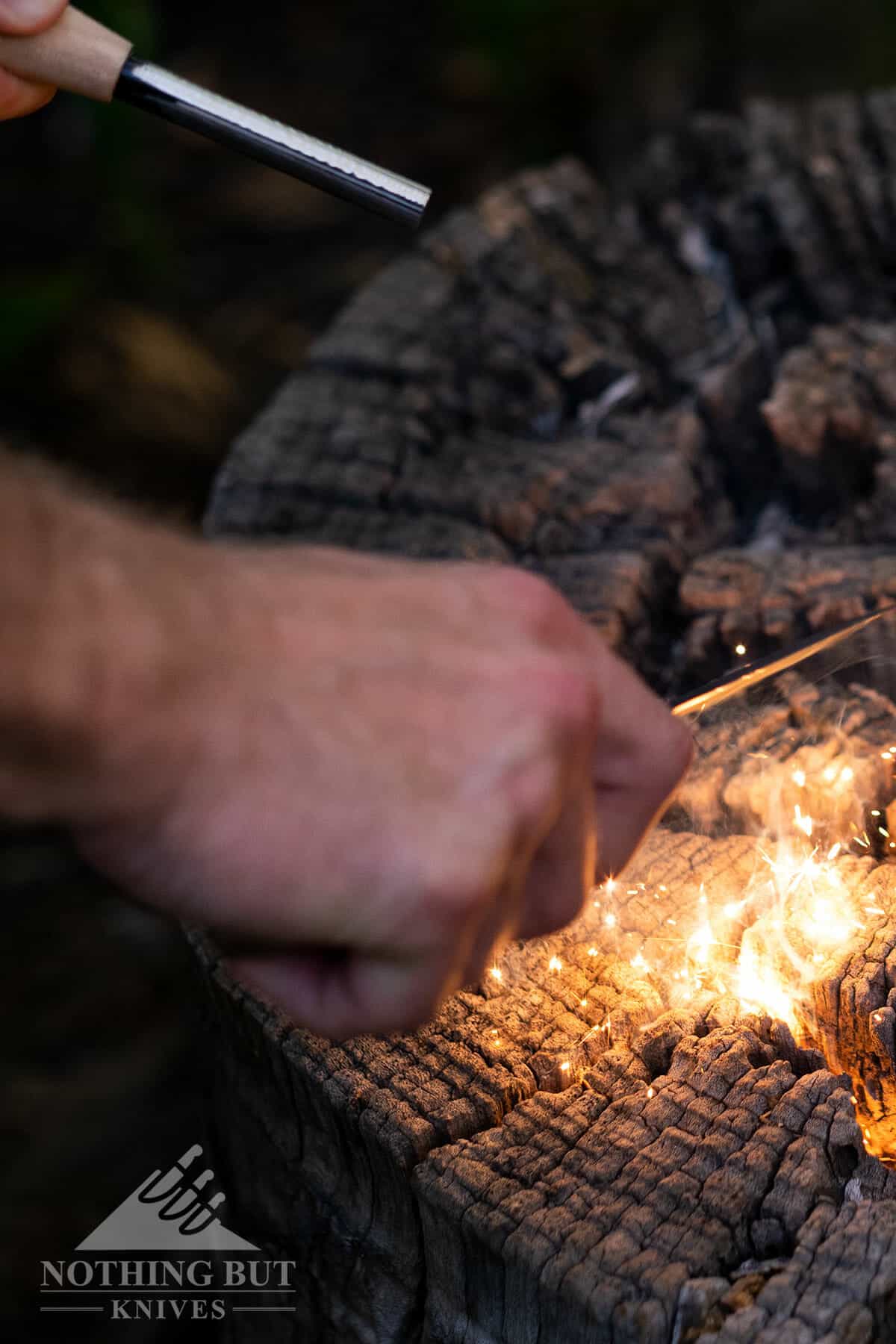
This throws some good, strong sparks. The only knife I’ve used that sparks easier than this is the Buck Selkirk, and that’s only by a thin margin. I was able to to get it to light up along the whole spine, and it was about as easy to spark near the tip as it was near the handle. That combined with the great handle ergonomics make for a pretty fun time.
The only issue is that the coating comes off a little with the ferro rod. I noticed little embers falling off the spine after a few strikes, and after I was done there were slivers of steel showing through the coating in a couple spots on the corners of the spine.
This wouldn’t normally be an issue, but since Buck went with 5160 steel, that coating is kind of important. The coating and my own personal care are the only things coming between this blade and rust, since there’s just barely enough chromium in 5160 (about 0.7 – 0.9%) to be considered an alloy steel.
It’s still not a huge issue; just remember to watch those spine corners and the edge of the knife. I don’t know if a Buck warranty covers the blade coating, but the worst case scenario is that you have to put some steel wool and elbow grease into the knife and get into the habit of oiling the blade a lot more. This knife is good enough to warrant that amount of attention.
The Thin Tip Problem
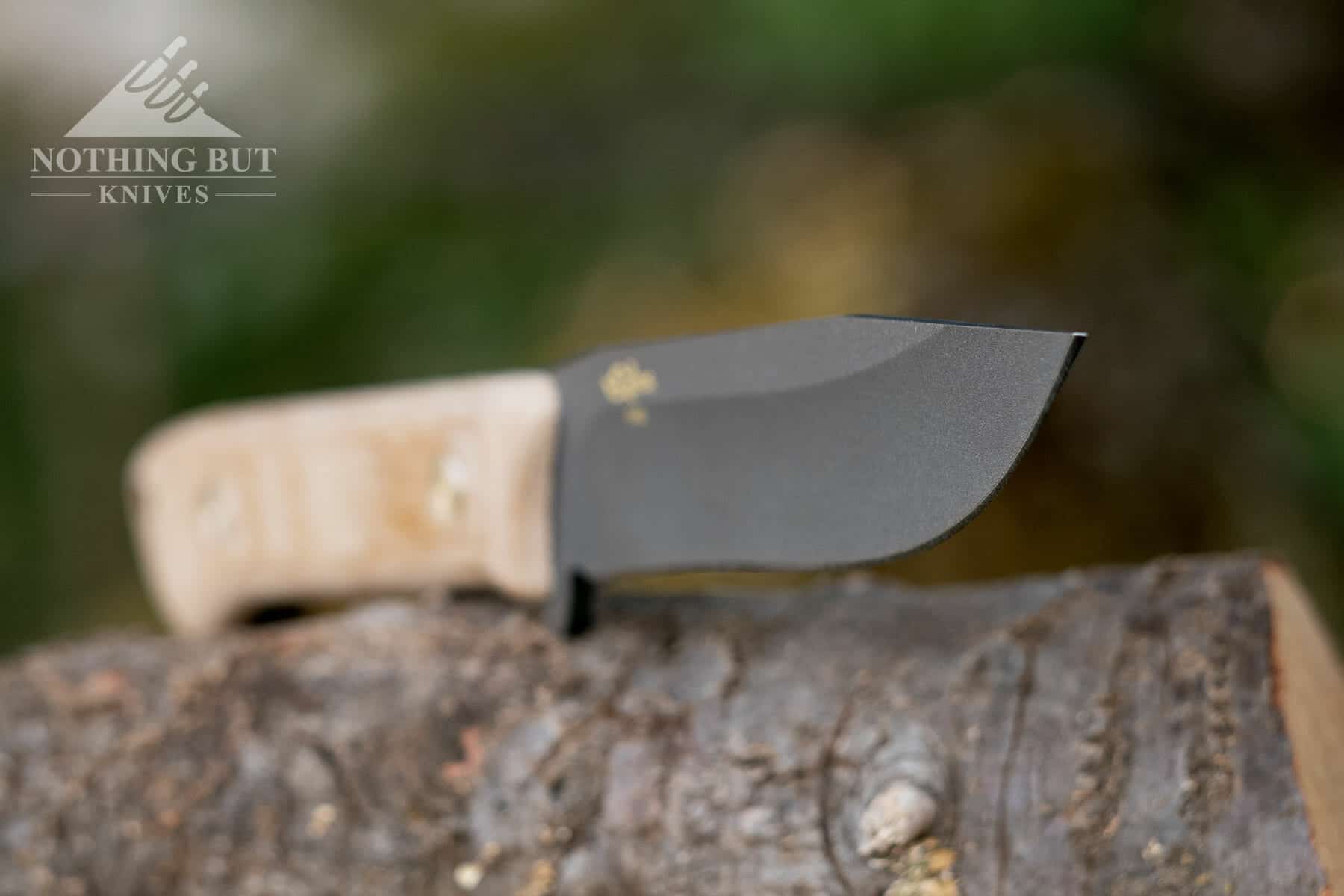
If it has one major problem, it’s the thin tip. That hasn’t come up as a problem for me, but a few people have chipped it off while chopping or batoning. Ever since they released the black coated version of the Compadre that’s the most common complaint I’ve heard about it. I would hazard to guess the people who chipped it weren’t chopping or batoning very well, but since Buck markets this knife as an all around tough camping knife, it would have made sense to make that tip a bit more stout.
I think the logic behind grinding is so thin was so it could pierce into game easier to get your cut started while skinning. That might stop being so useful when you get down to separating the pelvic bone, but that’s also probably why Buck went with such a soft steel.
Here’s my defense of the thin point:
- If you’re treating your knife right, it won’t be an issue 90% of the time,
- Buck will regrind it for you for free if it breaks,
- The steel is soft enough that you can grind your own damn knife point the way you want it.
I like this blade the way it is. My only problem is that the grind gets a little uneven near the tip, but I didn’t even notice that until after we’d done most of our tests, so it clearly wasn’t inhibiting my cuts that much.
Batoning, Chopping, and Making Pointy Things
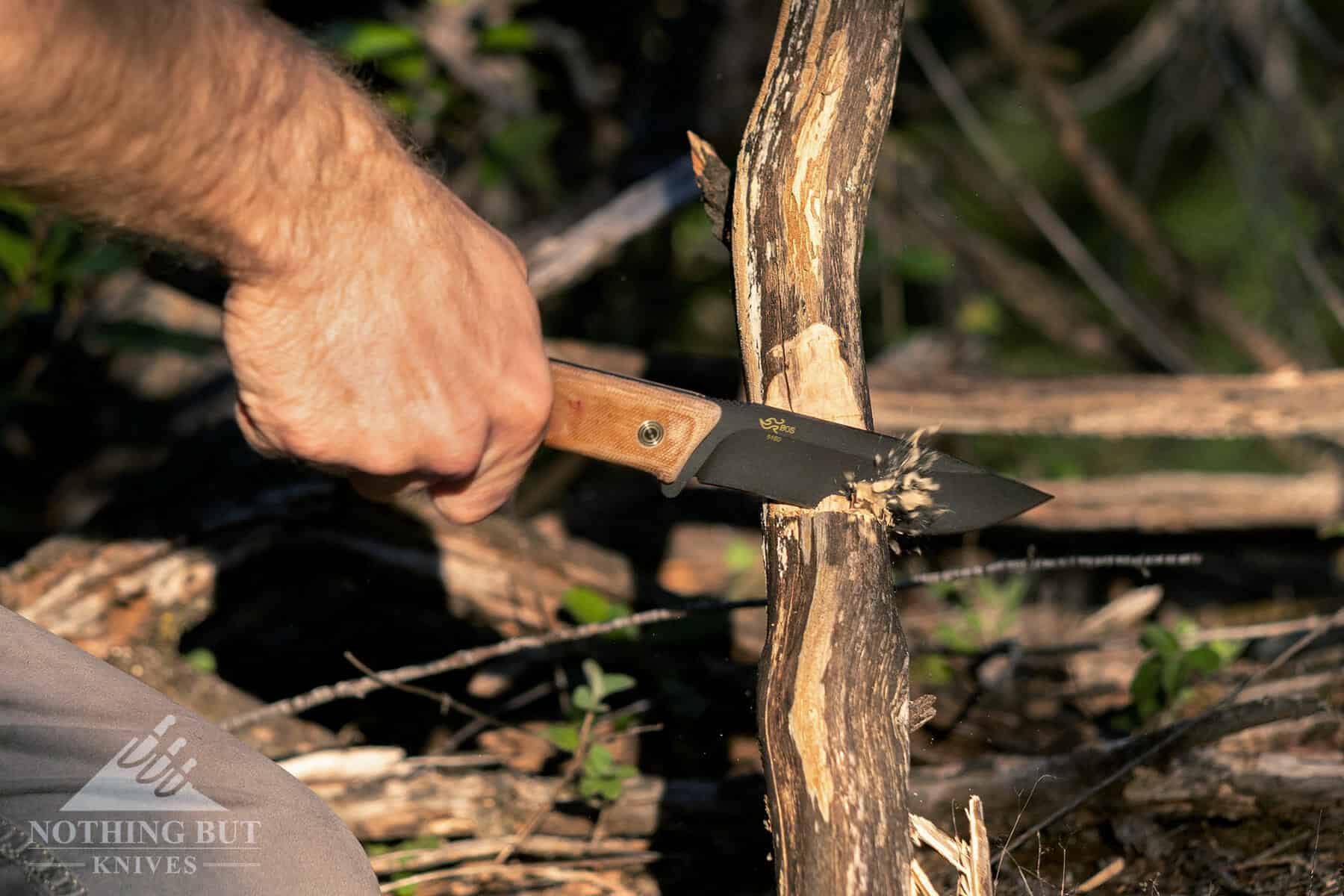
The Compadre does a lot of different things really well, so it’s hard to talk about it without jumping around and sounding like a crazy person.
We did all our usual bushcraft tests with this: chopping, batoning, feathersticking, sparking on a ferro rod. It did great on most of those. It sailed through the rope without too much pressure; made some nice, thin feather sticks with this edge; and the handle provides just enough control that batoning and chopping go pretty quick and let you get some decent cuts of firewood after.
I mentioned before that I had to hammer a little farther down the log to get a good split when I batoned, and that’s likely due to the choice of grind, but its till got me where I needed to go.
Everything was easy enough that almost all the problems that came up were mostly because of my own lack of skill.
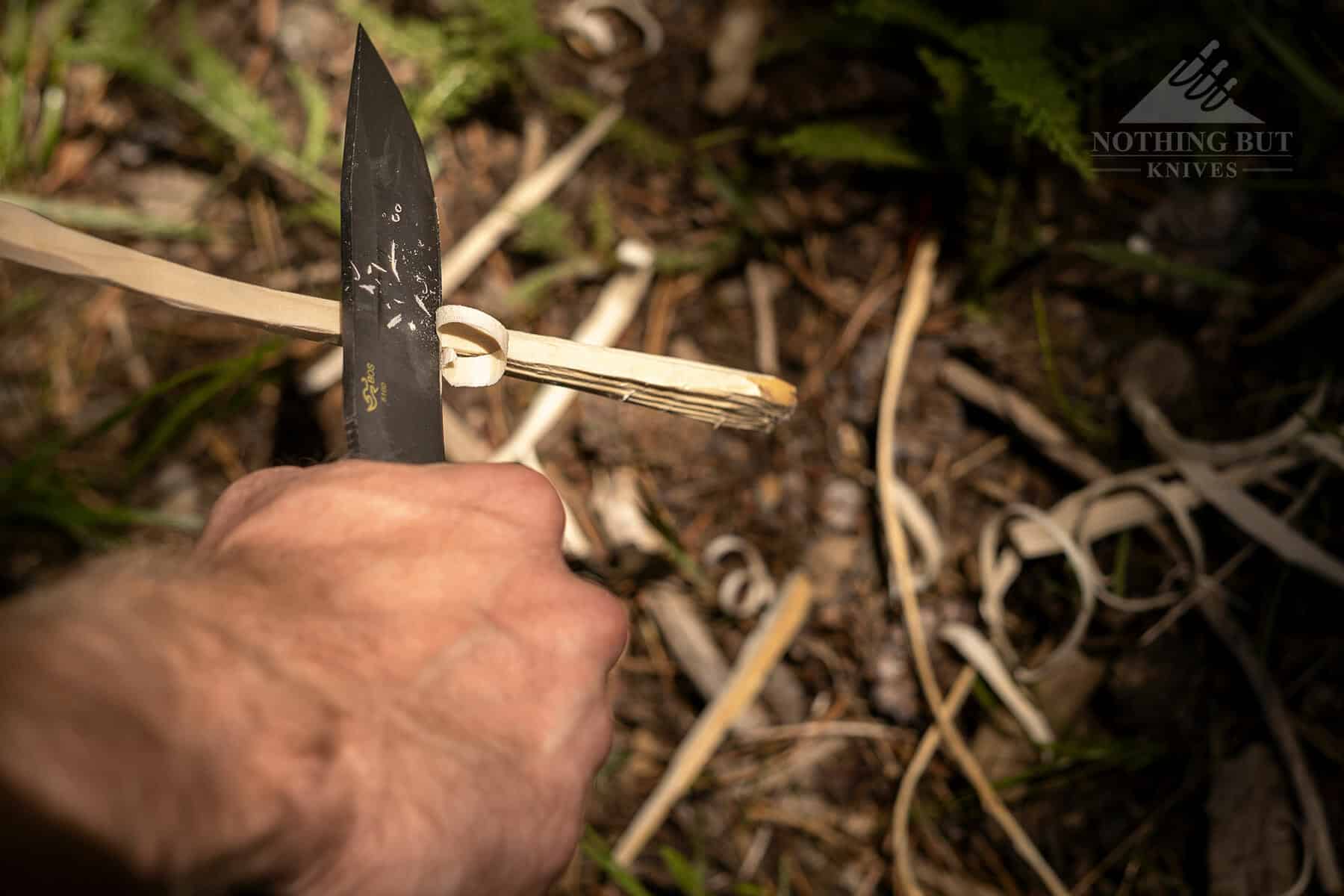
That became really apparent when I used it to make skewers for shish kabobs. Even when I cut a log down into thin slivers that I had to carve to a point, the Compadre Camp was easy to cut with, which is impressive considering its size. It’s something I would normally go to the Guardian 3 for, but this knife cut clean shavings all the way through hacking up wood to make about 6 or 7 skewers.
I did break a few in half and cut some of them way too thin, but it was almost never because the edge wasn’t cutting right. I was just being clumsy and not paying attention.
I wouldn’t stick with this knife if I wanted to do some more sophisticated whittling, and I did end up taking out my Rat 2 to finish off a couple of the points for the skewers. But the Compadre Camp took me most of the way there. If it were the only thing we’d had up in the mountains we would have been just fine.
Comparison and Alternatives
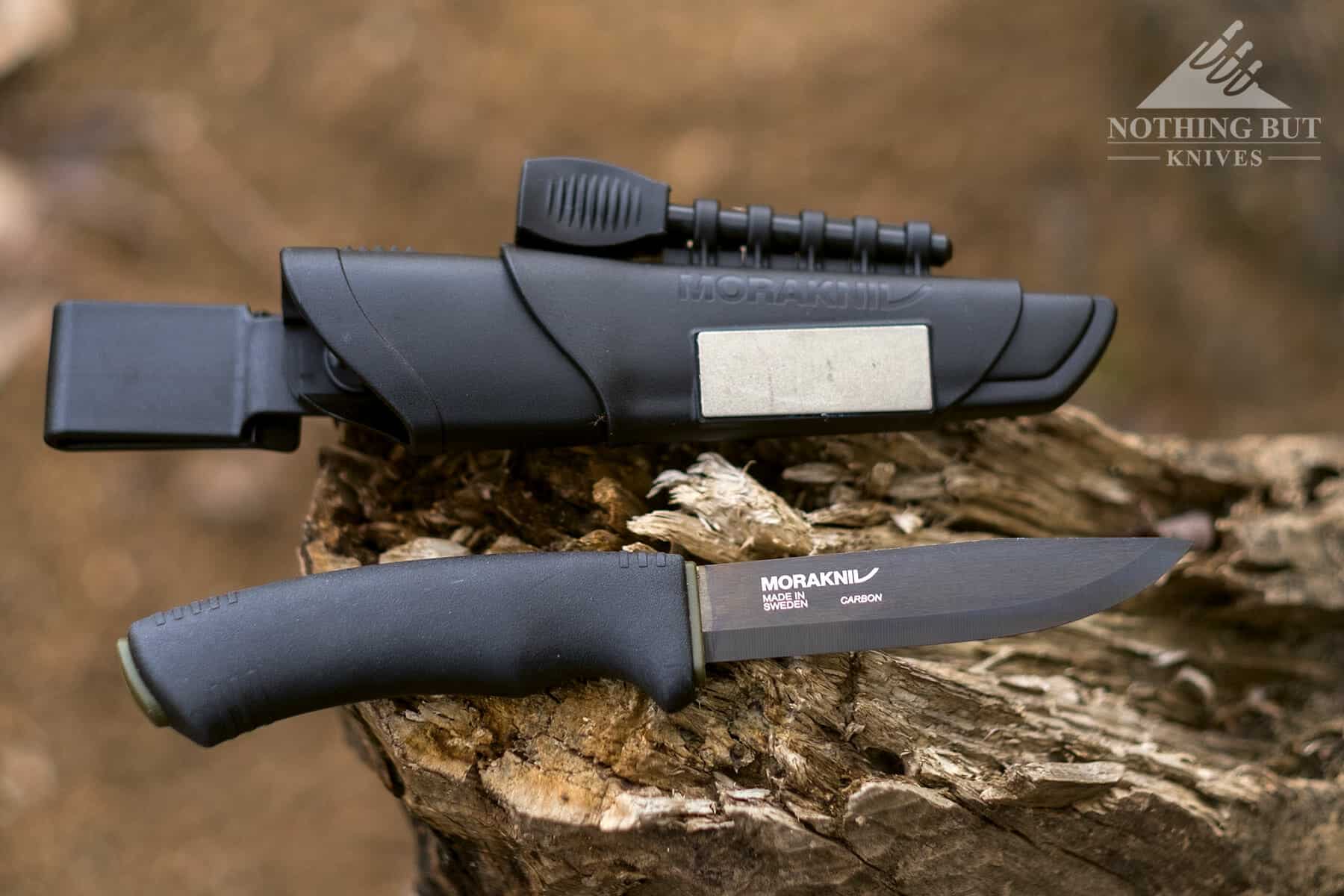
At $100, there are a lot of options to set next to the Compadre Camp. The three most common comparisons I see are the Mora Garberg the Mora Bushcraft Black (pictured above) and the ESEE 4.
The Garberg seems like strong competition for the Compadre. It has tough stainless steel, and a Scandi grind that I’d personally be more comfortable with than the hollow grind on the Compadre. I mean, most Mora knives are better alternatives to just about any fixed-blade survival knife you might be looking at, and the existence of a full tang Mora with several carrying options including MOLLE compatible systems has made that a much harsher truth. The Garberg does fall behind in comfort, though, and it doesn’t have a sharpening choil. I’d also argue it doesn’t look as good, but at this point that’s probably a biased opinion.
The ESEE 4 is both more expensive and not as comfortable. But like the Mora, ESEE offers a lot of different sheaths to match your carrying style, and the steel they use has a similar toughness with better edge retention and corrosion resistance. It also has a flat grind, but the edges of these knives pretty opposite, and while the ESEE might be better at hard use chopping and batoning, it’s probably not as slicey.
I’d also put the Buck Selkirk up as an alternative. It’s not as comfortable and it’s made in China, but it’s a lot more corrosion resistant, and the stock sheath lets you carry horizontally. It also usually runs about $30 cheaper, so there’s that.
The Condor Swamp Romper is a close run too (and one of our other favorite camp knives). You’ve got some similarities in comfort and versatility, and the Swamp Romper is a little less expensive, but it’s not as sharp and the sheath doesn’t ride quite as well as the Compadre.
If you don’t mind a significant price increase, the Reiff F4 is a camper’s dream knife, and it is also made in the USA.
The Civivi Cloud Peak has a retro look and it is more of a hunting knife if that is what you are in the market for.
Closing Arguments After a Few Weeks of Testing
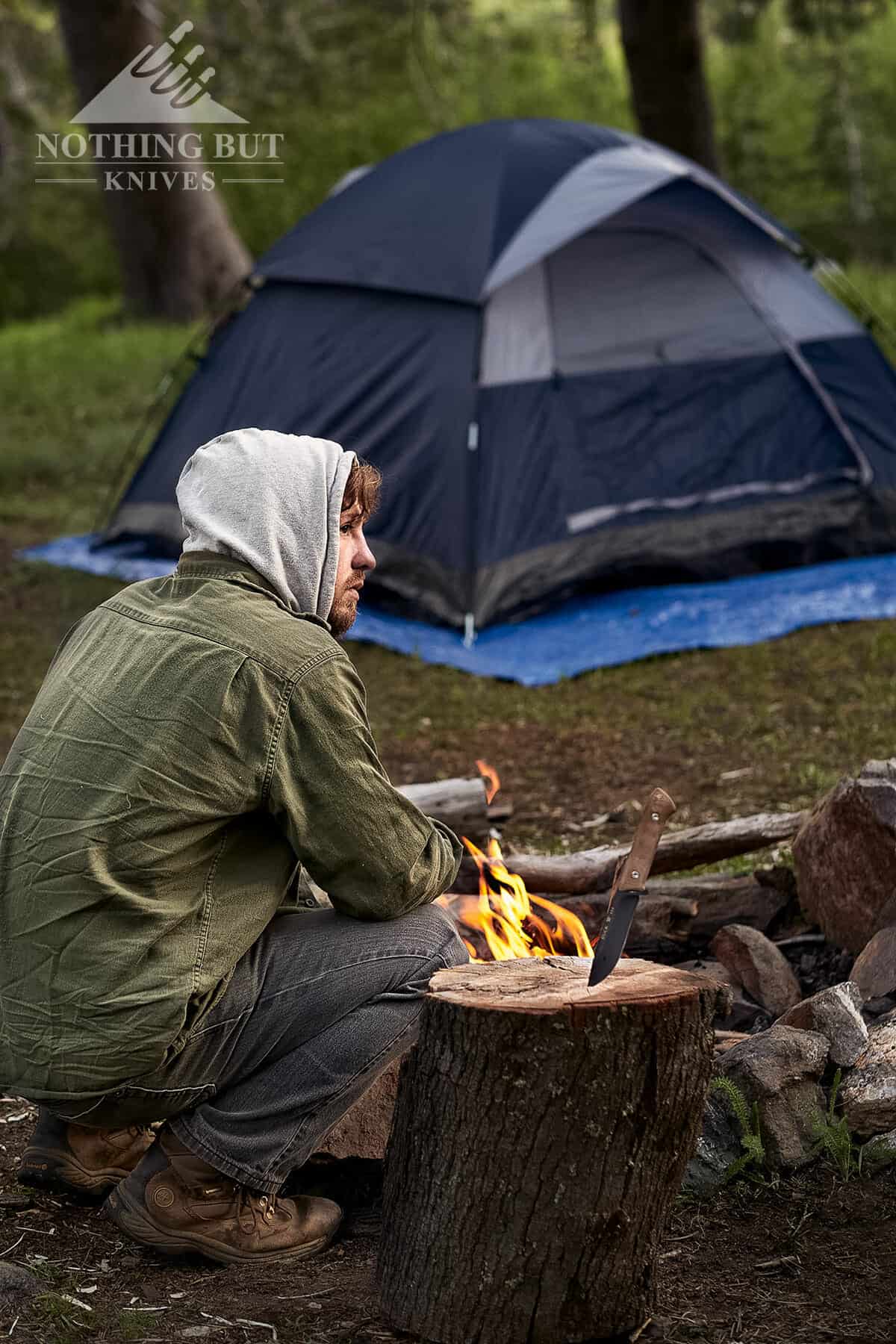
Buck’s Compadre Camp has made my list of knives to automatically recommend to anyone who expresses any remote interest in getting a new fixed blade knife, especially if they go camping at least once a year.
It will do everything I’d want to do at a campsite well. I can start a fire, I can chop the wood and baton kindling off those pieces for the fire, I could make tent stakes and skin game. The only thing I’d have to look out for through all that is snapping the tip and rust spots. And both of those should be easy enough to avoid so long as I keep it dry and don’t do anything stupid with it.

Thank you for the review and such great photos. I just discovered this knife and love the classis look of it.
It is nice to see Buck design something in-between Mora and Essee, hopefully they will continue to import on this design.
Thanks Z Man. Glad you liked it. We are also hoping to more versions of the Compadre and similar designs from Buck.
good write up on one of my favorite knives